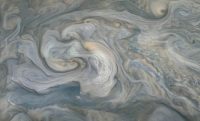This illustration uses data obtained by NASA’s Juno mission to depict high-altitude electrical storms on Jupiter. Juno’s sensitive Stellar Reference Unit camera detected unusual lightning flashes on Jupiter’s dark side during the spacecraft’s close flybys of the planet. (NASA/JPL-Caltech/SwRI/MSSS/Gerald Eichstädt)
Home This illustration uses data obtained by NASA’s Juno mission to depict high-altitude electrical storms on Jupiter. Juno’s sensitive Stellar Reference Unit camera detected unusual lightning flashes on Jupiter’s dark side during the spacecraft’s close flybys of the planet. (NASA/JPL-Caltech/SwRI/MSSS/Gerald Eichstädt) This illustration uses data obtained by NASA's Juno mission to depict high-altitude electrical storms on Jupiter. Juno's sensitive Stellar Reference Unit camera detected unusual lightning flashes on Jupiter's dark side during the spacecraft's close flybys of the planet. (NASA/JPL-Caltech/SwRI/MSSS/Gerald Eichstädt)
This illustration uses data obtained by NASA’s Juno mission to depict high-altitude electrical storms on Jupiter. Juno’s sensitive Stellar Reference Unit camera detected unusual lightning flashes on Jupiter’s dark side during the spacecraft’s close flybys of the planet. (NASA/JPL-Caltech/SwRI/MSSS/Gerald Eichstädt)



